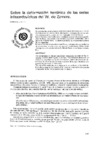Mostrar o rexistro simple do ítem
Sobre la deformación hercínica de las series infraordovícicas del W. de Zamora
| dc.contributor.author | Quiroga, J. L. | |
| dc.date.accessioned | 2010-01-22T12:35:15Z | |
| dc.date.available | 2010-01-22T12:35:15Z | |
| dc.date.issued | 1981 | |
| dc.identifier.citation | Cadernos do Laboratorio Xeolóxico de Laxe, 1981, 2: 155-168 ISBN: 84-7492-080-9 | es_ES |
| dc.identifier.isbn | 84-7492-080-9 | |
| dc.identifier.uri | http://hdl.handle.net/2183/5752 | |
| dc.description.abstract | [Resumen] Se estudian las características de la deformación hercínica en un sector del Paleozoico de Zamora (NW. de España), correspondiente a un dominio mesozonal y constituído por materiales infraordovícicos. Las estructuras observadas son el resultado de una deformación polifásica hercínica. Las estructuras ,menores aparecen controladas por el grado de metamorfismo, la anisotropía litológica y la geometría previa de los materiales. La estructura mayor, puesta de manifiesto, corresponde a un antiforme de tercera fase, de gran amplitud, en cuyo núcleo llegan aflorar neises microglandulares, equiparables al «Olio de Sapo» en su facies de grano fino. | |
| dc.description.abstract | [Abstract] The deformation in the pre-ordovician mesozonal materials of Northwestern Zamora (NW Spain) is studied. The observed structures are caused by polyphase hercynian deformation. Minar structures are determined by the intensity of metamorphism, lithologic anisotropy and preexisting geometry of the rocks. The main first arder structure observed is an antiform of the third deformation phase in the core of which coop ont microglandular gneises comparable to the fine grained «Olio de Sapo» | |
| dc.language.iso | spa | es_ES |
| dc.publisher | Universidade da Coruña | es_ES |
| dc.title | Sobre la deformación hercínica de las series infraordovícicas del W. de Zamora | es_ES |
| dc.type | info:eu-repo/semantics/article | es_ES |
| dc.rights.access | info:eu-repo/semantics/openAccess |






